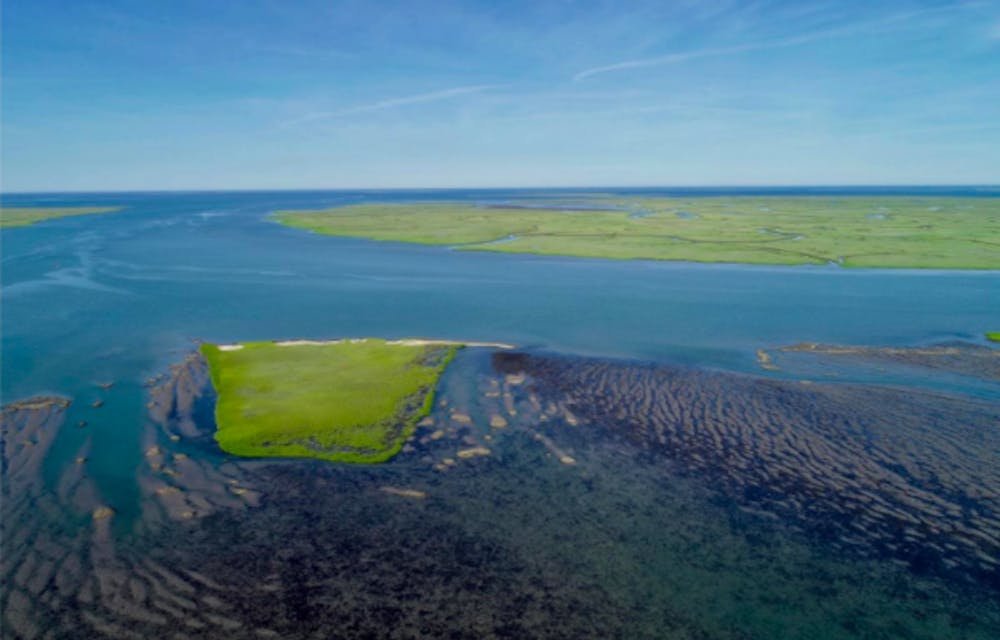Marine seagrass, specifically eelgrass and turtle grass, proliferate in the shallow waters of estuaries and bays. These meadows of seagrass are an important part of many marine ecosystems, as they provide critical habitats for an abundance of fish, shellfish and invertebrates. They facilitate biodiversity, act as natural sponges to filter nitrogen out of the water and increase water quality and clarity by slowing the current down and increasing the stability of the sediment layer.
A group of University environmental scientists collaborated to form the Long-Term Ecological Research project in order to integrate long-term observations and experiments on seagrass ecosystems to track how they change over time and predict future vulnerabilities.
Karen McGlathery, director of the Long-Term Ecological Research project, got involved in the project through her interest in the possibility of cultivating and maintaining these seagrass meadows off Virginia’s eastern coast.
“There was no seagrass,” McGlathery said, referring to the start of the project about 25 years ago.
In the late 1800s, before Virginia seagrasses were completely wiped out by both a mold infection and large hurricane off the coast in 1932, there had been flourishing seagrass beds off the coast. Before proceeding with any actual regrowth, University scientists started by taking preliminary tests of the water quality to see if the seagrass would be able to survive in the current water conditions, and their results concluded that growth was possible.
“We partnered with the Virginia Institute of Marine Science, who actually did the seeding to figure out where [regrowth] could happen and do some of the preliminary work,” McGlathery said. “The Virginia Coastal Zone Management Program provided a lot of money for the seeding, [while] all the studies that U.Va. and the Long-Term Ecological Research program has done has been funded by the National Science Foundation.”
Graduate College student Amelie Berger pointed out that the study is in a prime location to study the effects of climate change on seagrass and the surrounding marine environment, as the coastal bay is less polluted by human stressors of coastal development and runoff. This allows the lab to focus on how the health of the seagrasses impacts the surrounding ecosystems they are a part of.
“[We are] trying to link it to other ecosystems nearby,” Berger said. “There are marshes, barrier islands, oyster reefs. The seagrass meadow is part of a larger system and we're trying to connect them now to see how carbon and nutrients flows between them.”
Peter Berg, a research professor in the department of environmental sciences, played a role in the project by focusing his research on seagrass metabolism.
“Seagrass breed like we do, but they are more advanced as well,” Berg said. “They can produce oxygen.”
During the daytime, seagrass utilizes sunlight for photosynthesis to produce oxygen and release it into the water, but during the nighttime they respire, consuming oxygen in the nearby environment.
University researchers have learned that by measuring oxygen output they can determine how healthy the seagrass is. Additionally, they can predict how much carbon the meadows are taking out of the water — or out of the atmosphere — and storing in the sediment below them. But it is not easy to measure the exchange of oxygen and carbon at the sea floor. Most techniques disturb the seagrass by enclosing a patch of it in a dome to measure the changes inside.
“By doing that, the light is not the same, the supply nutrients are not the same,” Berg said. “[With] the new technique that we have developed, we can scan over the sea floor with these high tech sensors we have and from that we can extract the metabolism.”
The development of new sensors and flux calculations by Berg’s Aquatic Eddy Covariance Lab allows measurements of light, flow and exchange of nutrients to be made with little to no disturbances to the natural environment, offering more precise data while leaving the seagrass in place.
The restoration project faced a setback in 2015 when a marine heatwave — caused by rising temperatures and the increasing impacts of climate change — caused 90 percent of the seagrass at their main site to die off. Through close monitoring, almost all of the seagrass has grown back completely in the past five years, though several sites still lag behind in recovery.
“The problem is some of that carbon that was stored in the sediment is gone, and it takes years to build that up again, so we want to avoid these events,” Berg said.
In addition to heat stress from rising temperatures, the study is also monitoring the effect of sulfide toxicity on the health of the seagrass beds. Sulfate reduction happens when there is less oxygen available and organic material decomposes by taking sulfate out of the water and producing sulfide. Normally healthy seagrass can fight off the production of sulfide, but with the addition of heat stress, they are unable to produce as much oxygen and can die off from the sulfide toxicity.
By monitoring the health of the meadows and identifying the threats against them, the restoration project has been able to model the resilience of the seagrass over time and determine the key factors, temperature and depth to help decide future locations for seeding.
As the project goes into its 20th year of restoration, the researchers credit the long-term collaboration between students, faculty and outside institutions to the success of the restoration, and their passion continues to extend the project forward.
“There was nothing and now there's just this, you know, beautiful lush seagrass meadows,” McGlathery said.







